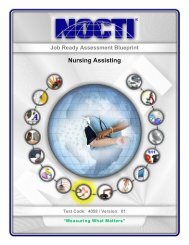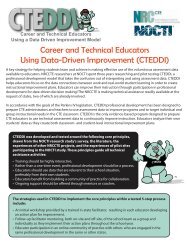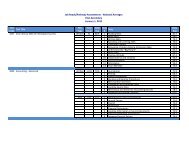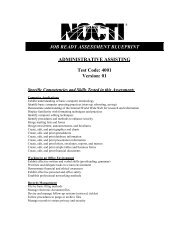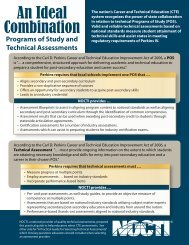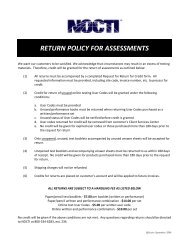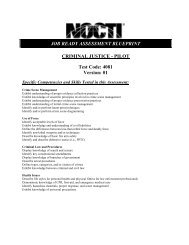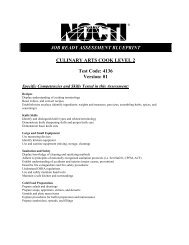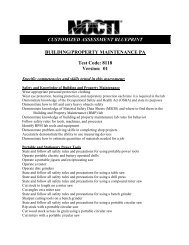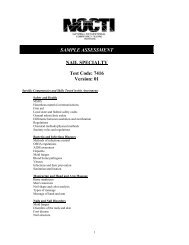Job Ready Assessment Blueprint Electrical Construction - nocti
Job Ready Assessment Blueprint Electrical Construction - nocti
Job Ready Assessment Blueprint Electrical Construction - nocti
Create successful ePaper yourself
Turn your PDF publications into a flip-book with our unique Google optimized e-Paper software.
<strong>Job</strong> <strong>Ready</strong> <strong>Assessment</strong> <strong>Blueprint</strong><strong>Electrical</strong> <strong>Construction</strong>Test Code: 3030 / Version: 02“Measuring What Matters”
<strong>Electrical</strong> <strong>Construction</strong>Specific Competencies and Skills Tested in this <strong>Assessment</strong>:General Information• Explain the purpose of OSHA• Match electrical positions andresponsibilities• Identify professional organizations andtheir purposeSafety• Demonstrate use of appropriatewearing apparel• Demonstrate safe use of hand andpower tools• Apply techniques for lifting objects• Demonstrate ladder safety• Techniques for working on live circuits• Explain the purpose of grounding• Explain OSHA rules for approaching anunknown circuit• Rescuing a victim from a live electricalconductor• Apply techniques and practices of fire prevention• Choose the fire extinguisher appropriate for fire type• First-aid policies/proceduresMeters, Measurements, Testing• Characteristics of meters and measuring devices• Use measuring devices• Select meters appropriate for task• Connect and use electrical test equipment• Use formulas to determine calculations• Determine current• Determine voltage output• Interpretation and conversion of readings• Troubleshoot fusesPage 1 of 10NOCTI <strong>Job</strong> <strong>Ready</strong> <strong>Assessment</strong>Copyright © NOCTI 2007 All Rights Reserved
<strong>Electrical</strong> <strong>Construction</strong>Specific Competencies and Skills continued:• Identify proper location for disconnect• Overcurrent devices permitted in a panel board• Select correct type of fuses• Conductors for motors in accordance with NEC• Ampacity in relation to current rating of a single motor• Explain color coding used for conductor• Determine how equipment is properly grounded• Proper wiring associated with swimming pools and spas<strong>Blueprint</strong>s, Drawings, Diagrams, and Symbols• Identify and use electrical symbols and drawing conventions• Interpret and use specifications, print and job site drawings• Interpret and compare wiring and schematic diagrams, and cable layouts• Conversion of measurements• Identify recommended height for devices and components• Draw working circuitPlanning, Layout, and Estimating• Perform basic math calculations andconversions• Use specifications, prints, and job sitedrawings• Demonstrate planning and layout procedures• Estimate the amount of wire required• Calculate wattage requirements• Estimate amount of conduit requiredAC Theory, Conductors, Magnetic Theory• Characteristics of AC series and parallelcircuits• Capacitance, impedance, current, voltage, resistance• Calculate power consumption, dissipation, loss• Determine power factor status• Determine principles of magnetic theory• Principles and theory of alternating current waveformPage 3 of 10NOCTI <strong>Job</strong> <strong>Ready</strong> <strong>Assessment</strong>Copyright © NOCTI 2007 All Rights Reserved
<strong>Electrical</strong> <strong>Construction</strong>Specific Competencies and Skills continued:Electronics• Function/characteristics of rectifiers, inverters, and filters• Elements used in semiconductors and conductors• Test Operating Circuits• <strong>Electrical</strong> terms, abbreviations, acronyms,and symbols• Communications systemsDC: Basic Electric and Electron Theories• Characteristics of DC series and parallelcircuits• Resistance, capacitance, inductance,voltage, current• Calculate power consumption, dissipation,loss• Identify materials as insulators and non-insulators• Explain how electricity is made• List the components of a circuit• Use color coding to identify specific wires• Relationship of temperature and conductivity• Apply Ohm's Law• Design a basic circuit• Relationship of electricity, electrons, and atomsLow Voltage Systems• Identify components of a low-voltage system• Choose appropriate wire• Identify voltage for low-voltage system and controls• Install, test a low-voltage system• Apply knowledge of signal and control systemsWiring, Circuits, and Installation• Wiring system appropriate for the installation• Knowledge of switching circuits and techniques• Install and support cable• Install cable through structural membersPage 4 of 10NOCTI <strong>Job</strong> <strong>Ready</strong> <strong>Assessment</strong>Copyright © NOCTI 2007 All Rights Reserved
<strong>Electrical</strong> <strong>Construction</strong>Specific Competencies and Skills continued:• Wire pulling techniques for wiring methods• Install proper boxes, devices, and trim• Rough-in power and telephone wires• Wire switched outlets• Splice, terminate, and connect wire• Test completed installation• Troubleshoot circuits• Determine current requirements• Determine location and size of serviceentrance• Install service equipment• Install fittings, connectors, and components• Identify proper ground system• Identify circuit breakers and fusesRaceway and Conduit Bending• List causes of excessive heat in conductors• Install proper number of conductors inraceways• Determine type of conduit required• Cut, ream, deburr, and bend conduit• Install rigid conduit, EMT, and PVC with supports• Burial depths of conduitsTransformers• Primary and secondary windings• Voltage and current for primary/secondary windings• Determine proper polarity as required• Explain and calculate transformer efficiency• Determine KVA capacity and load• Identify for Delta or Wye connectionMotors, Motor Control Circuits, and PLCs• Identify motor controls• Characteristics of various types of controls• Switches and their functionsPage 5 of 10NOCTI <strong>Job</strong> <strong>Ready</strong> <strong>Assessment</strong>Copyright © NOCTI 2007 All Rights Reserved
<strong>Electrical</strong> <strong>Construction</strong>Specific Competencies and Skills continued:• Wire a three-phase magnetic starter• Identify/connect motor connections• Install, test, and troubleshoot circuits• Reverse motor rotation• Calculate motor efficiency• Create motor control circuit diagram• Protection devices, specific purposes• Identify and interpret motor nameplate• Understand programmable logic controllers (PLCs)• Develop, program, operate, troubleshoot PLCsLighting• Incandescent and high-intensity discharge lamps• Coding of fluorescent tubes• Understand installation of lightingfixtures• Diagnose lighting problemsBasic Computer Skills• Characteristics and usage of storagedevices• Identify basic keyboarding skills• Identify input and output devices• Understand how to back-up files• Understand need and importance of surgeprotection• Basic computer terminologyPage 6 of 10NOCTI <strong>Job</strong> <strong>Ready</strong> <strong>Assessment</strong>Copyright © NOCTI 2007 All Rights Reserved
<strong>Electrical</strong> <strong>Construction</strong>Written <strong>Assessment</strong>:Administration Time: 3 hoursNumber of Questions: 185Areas Covered:Page 7 of 10NOCTI <strong>Job</strong> <strong>Ready</strong> <strong>Assessment</strong>Copyright © NOCTI 2007 All Rights Reserved
<strong>Electrical</strong> <strong>Construction</strong>Sample Questions:Which of the following national organizationsis an independent, non-for-profit, productsafetytesting, and certification organization?A. ANSI – American National StandardsInstituteB. NEMA – National <strong>Electrical</strong>Manufacturing AssociationC. UL – Underwriters LaboratoriesD. OSHA – Occupational Safety andHealth AdministrationThe National Electric Code is based onA. part 70 of the NFPA CodesB. part 80 of the NFPA CodesC. part 70 of OSHA RegulationsD. part 80 of OSHA RegulationsIf 689 feet of conduit is required for a job, how many lengths of conduit areneeded?A. 60B. 68C. 69D. 70Intermediate metal conduit, when compared to rigid conduit, isA. lighterB. longerC. harder to workD. harder to connectA _______ computer device is most responsible for CPU clock speed.A. memoryB. high speed counterC. timerD. vibrating crystalPage 8 of 10NOCTI <strong>Job</strong> <strong>Ready</strong> <strong>Assessment</strong>Copyright © NOCTI 2007 All Rights Reserved
<strong>Electrical</strong> <strong>Construction</strong>Performance <strong>Assessment</strong>:Administration Time: 2 hours and 30 minutesNumber of <strong>Job</strong>s: 2Areas Covered:75% Switch Controls, Conduit Bending, and GFCI ReceptaclesKnowledge of circuit layout, Draw product wiring design, Select appropriatematerial, Installation of boxes, wires and device, Wiring installation methods,Installation of device, Functionality, Accuracy of measurement, Proper bending andcutting techniques, Installation of conductors, Installation of GFCI, and Safetyand workmanship25% Doorbell CircuitIdentify and select components, Installation of components, Test/troubleshootcomponents, and Safety and workmanshipPage 9 of 10NOCTI <strong>Job</strong> <strong>Ready</strong> <strong>Assessment</strong>Copyright © NOCTI 2007 All Rights Reserved
<strong>Electrical</strong> <strong>Construction</strong>Sample <strong>Job</strong>:Maximum Time:Participant Activity:Doorbell Circuit30 minutesThe participant will select the appropriate materials forthe job and follow a project plan to successfully install afunctioning doorbell circuit according to electrical codesand specifications.Page 10 of 10NOCTI <strong>Job</strong> <strong>Ready</strong> <strong>Assessment</strong>Copyright © NOCTI 2007 All Rights Reserved




